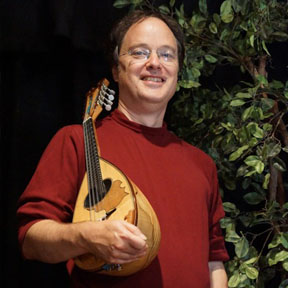« Chris Thile to take over Prairie Home Companion hosting. For real! |
Main
| Ashbury Mandolins, Zouks, Tenor Guitars »
 July 2, 2015 | New from Berklee Press: Exploring Classical Mandolin July 2, 2015 | New from Berklee Press: Exploring Classical Mandolin
 Exploring Classical Mandolin Exploring Classical Mandolin
Technique & Repertoire
August Watters
Berklee Press
Distributed by Hal Leonard Publishing
New from Hal Leonard and Berklee Press, a book from one of our favorite mandolin pedagogicalists, August Watters, Exploring Classical Mandolin; Technique & Repertoire. The New England composer/arranger and teacher is a leading authority in what can be considered "today's revival of this elegant instrument." His work as an internationally sought clinician has served him well in compiling an exceptionally authoritative work.
The book is organized into three sections. Part 1, practice methods including concepts and etudes, Part 2, classical mandolin repertoire, & Part 3, broader concert music arranged for solo mandolin. The approach is indisputably notation based, so anyone coming to the mandolin from a classic tradition whether mandolin or another instrument, will find the strategy more synergetic with their earlier educational experiences. There are many mandolin materials already published that teach mandolin concepts through folk music, TAB, and aurally, but this is best for the musician with some facility in reading music.
The book is also broader in historical and stylistic reach. Typically, the American mandolinist comes from a heavy folk/bluegrass approach not only to playing the instrument, but understanding its past and place amongst other instruments. Watters does a much more comprehensive analysis of its roots in a three century tradition, and injects the wider perspective of the mandolin on a global scale, including Italian, northern European, Japanese and even Israeli. This is not the approach for a mandolinist stuck on the concept of the instrument's purpose in melody and "chop," not a glorified cowbell. This is the mandolin in its fullest capacity.
Albeit, the techniques of picking and left-hand placement, including stroke variations and grip, and proper fret shifting are classical, but inarguably universal for ALL styles of playing. Basic theory concepts like arpeggios and chord function are attacked from a drill/exercise approach, but highly useful in developing the ear along with the hands. We became aware of Watter's scale variations a decade ago and still implement them in personal daily practice.
The advanced beginner to intermediate student will enjoy a slightly different approach to higher concepts of chord melody and improvisation. Usually it's chord symbol, theory, and some splicing of melody into the execution. This takes chord vocabulary and compound picking patterns and fuses them into another manner of tackling the skill. Same destination, different road.
The repertoire is diverse though chiefly European, but includes some folk tunes and is great for anyone to learn to enjoy and play for others.
Comparisons might be made to the recent release of Don Julin's Mandolin for Dummies. The question might come up, which of these two books should I get if I'm looking for something comprehensive, and I want history and international perspective in addition to some tips on techniques and exercises? Both will give you this, and if the answer cant be "get BOTH books," we'd suggest the beginner or advance beginner who comes from a formal education, including sight reading and some familiarity with classical literature might benefit more from this book.
One thing we want to make clear however, this is not just for the classical aficionado as the title implies. We fear the market scope might deny the broader tastes of the mandolinist who want the "classic" training and technique that will enhance any player's skill and aesthetic perspective.
Online video demonstrations and audio also available.
Purchase information: Exploring Classical Mandolin;Technique & Repertoire
August Watters
Berklee Press

Posted by Ted at July 2, 2015 8:18 PM

Disclaimer: In the 'Information Age' of the 21st Century,
any fool with a computer, a modem, and an idea can
become a self-professed 'expert." This site does not
come equipped with 'discernment.'
|



